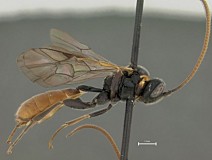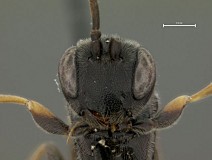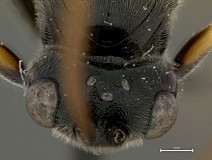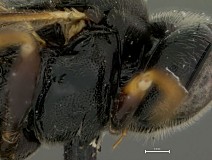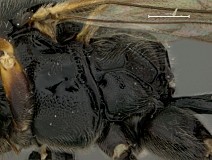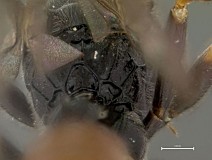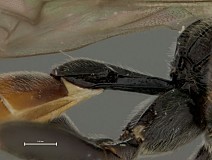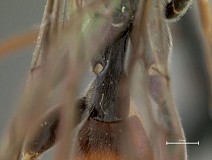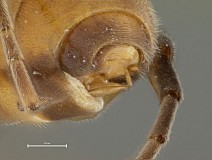Clypeus (Fig. 2) large; ventral margin with small, sharply pointed median tooth, margin otherwise weakly convex, clypeus in profile not protruding; epistomal sulcus absent. Malar space long, about 0.7 times basal width of mandible. Mandible with ventral tooth slightly longer than dorsal tooth; teeth bidentate in type species (Fig. 2), quadridentate in
quadridens. Face dorsally not extending as an elevated triangle between antennae (Figs 2, 3) unlike most Metopiinae; frons with elevated carina medially. Ocelli small (Fig. 3), lateral ocellus distinctly shorter than distance between ocellus and eye. Maxillary palp shorter than head height. Flagellomeres broader medially, narrower basally and apically. Occipital carina complete dorsally, joining hypostomal carina near base of mandible in type species, apparently incomplete ventrally in
quadridens. Epomia well-developed (Fig. 4). Dorsal end of epicnemial carina weak dorsally (Fig. 6), not extending to anterior margin of mesopleuron. Pleural carina complete, well-developed (Fig. 5); propodeum (Fig. 6) with complete posterior transverse carina; anterior transverse carina completely absent; median longitudinal carinae absent posteriorad posterior transverse carina, otherwise distinct and parallel-sided; lateral longitudinal carina present, well-developed; petiolar area well-defined and separated from combined, rectangular areola + basal median area. Legs with tarsal claws not pectinate. Fore wing (Fig. 1) with areolet. Hind wing with first abscissa of CU1 about as long as or slightly longer than 1cu-a. T1 (Figs 7, 8) narrow, nearly parallel-sided basally, distinctly broadening posteriorly into a distinct postpetiole; dorsal carinae low, barely visible; dorsal-lateral carina sharp for most of its length (Fig. 7); glymma absent or nearly so; spiracle distinctly posteriorad midlength. S1 extending to or nearly to spiracle, about 0.6 times length of T1. T2 thyridium present. Laterotergites of T2 and T3 completely separated by creases. Ovipositor (broken in Fig. 9) and sheath very short.
This description is based on material borrowed from the American Entomological Institute and is somewhat modified from that given by Townes (1971: 114) and Perkins (1962: 399-400).

